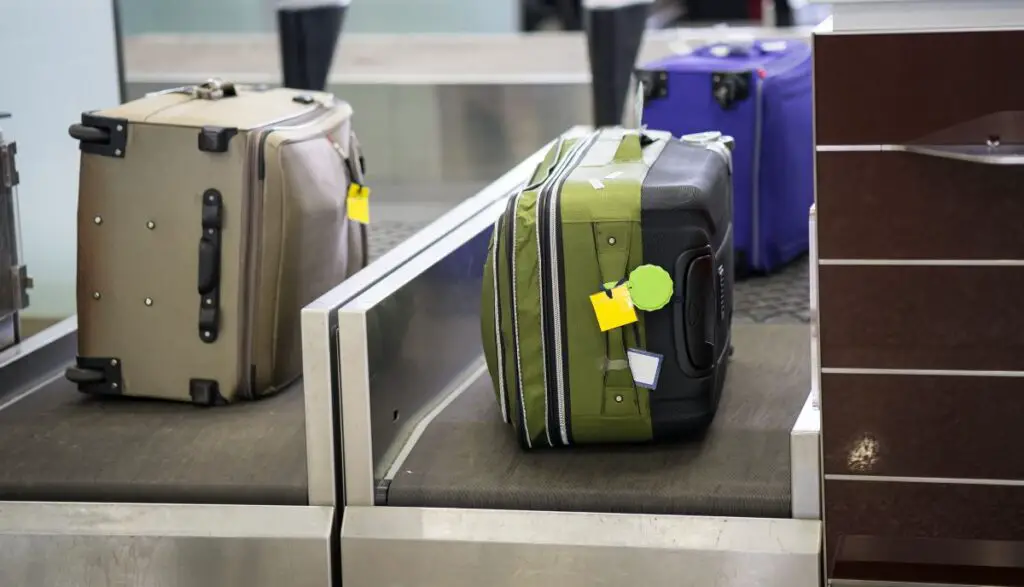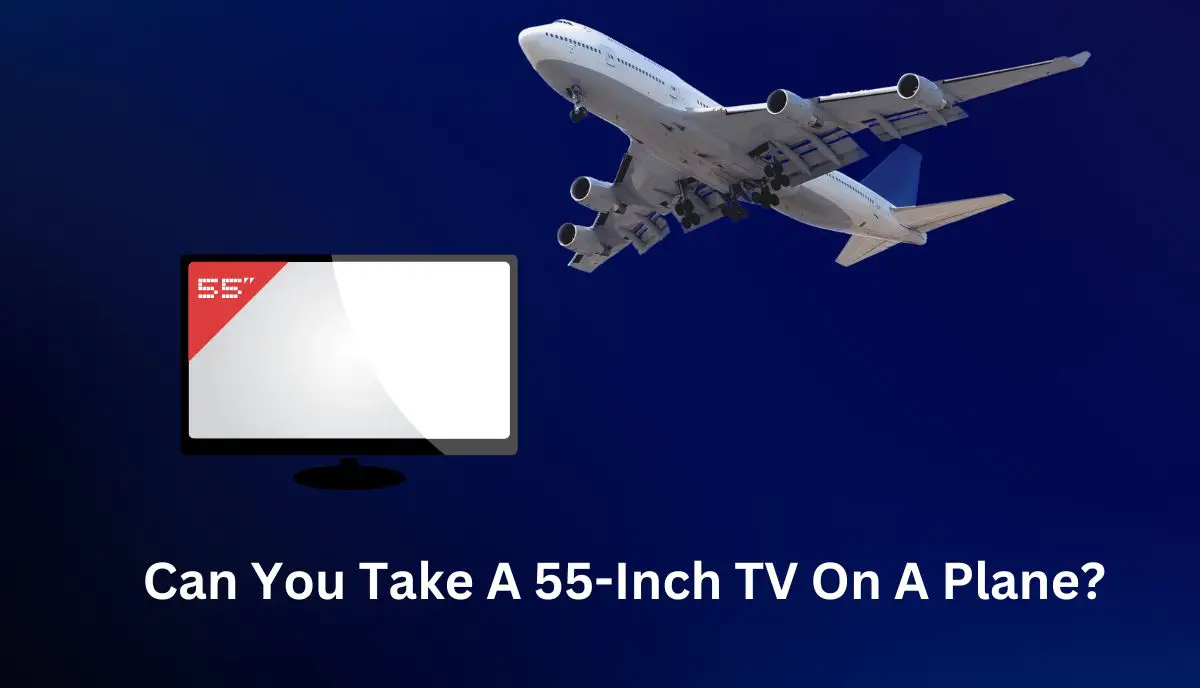Yes, you can take a 55-inch TV on a plane. Airlines generally allow it as checked baggage, adhering to size and weight limits. It’s advisable to check with your specific airline for regulations on both checked and carry-on options. Different classes and airlines may have varying size restrictions. Some airlines, like JetBlue, recommend keeping the TV in its original packaging for added protection. Be aware of additional fees for oversized items, and consider alternative options like professional shipping for added safety.
This is everything you should know:
- Checked Baggage
You can carry a 55-inch TV in checked baggage. The US Transportation Security Department says as much on its website. Keep the size and weight limits in mind. For instance, your airline may limit passengers to 23 kilograms.
- Carry-on Bags
Many transportation departments encourage consumers to keep fragile electronic items in carry-on bags. Naturally, the carry-on option will only work if your luggage can fit under the seat or in the overhead bin.
In other words, you should contact your airline ahead of time to determine whether a 55-inch TV will fit in the space allotted to you on the plane.
- Class
Are you flying economy, business, or first class? The category matters because it affects the volume of space allotted to each customer. For instance, Ramkishor Saini has noted in this Quora post that economy class on Qatar Airways can accommodate 32-inch TVs.
That figure jumps to 40 inches (Diagonal screen size) for business and economy class. They’ve also highlighted A320 and A321 aircraft, which can only permit 21-inch screens. If you check your airline’s platform, you will see guidelines specifying the size and weight limitations of carry-on and checked luggage.
- Airline
Different airlines are governed by different rules. However, most tend to agree on the standards associated with size and weight limitations for luggage. Consider the following:
1). Volaris
You can keep a TV in checked baggage on Volaris planes if you buy a regular fare ticket and the TV weighs less than 55 pounds. They accept TVs smaller than 62 inches.
2). Delta
You can keep a 55-inch TV as checked luggage on a Delta flight. But they will ask you to pay additional fees. More importantly, they expect customers to call them ahead of time. They need to know the TV’s dimensions.
3). Spirit
You can carry 55-inch TVs in checked luggage with Spirit. They will only demand additional fees if the TV exceeds 62 inches and 40 pounds (weight). If your TV’s dimensions exceed 62 inches, call the airline to determine the amount you must pay to travel with it.
4). American Airlines
A 55-inch TV falls within the 62-inch limit American Airlines permits when you buy a standard ticket. While they technically restrict the weight to 50 pounds, they accept 70-pound bags for business and first-class passengers.
Nonetheless, you should consult American Airways before carrying a heavy 55-inch TV to the airport. After all, some destinations have a reputation for rejecting overweight bags.
5). Southwest
You can bring a 55-inch TV as checked luggage on a Southwest flight. They will demand additional fees for TVs larger than 62 inches and heavier than 50 pounds.
6). JetBlue
You can bring a 55-inch TV on a JetBlue flight. They will charge overweight and oversized fees for TVs that exceed 62 inches and 50 pounds.
You’ve probably noticed a pattern by now. You can take a 55-inch TV on a plane, but you must check it as luggage. Most airlines limit TVs to 62 inches and 40 – 50 pounds. That includes Frontier, Hawaii, United, and Sun Country Airlines.
U.S. News has a guide showing the size and weight limits (carry-on and checked luggage) for every major airline. You can also consider the table on hands-off-my-suitcase, which shows the oversized and overweight limits.
Brands like American Airlines will accept TVs as large as 75 inches and 100 pounds. But again, you must carry the TV as checked luggage.
Is It Allowed To Carry A Large TV As Checked Luggage On A Plane?

Yes, it is allowed. Consider this flyDubai guide. In the TV section, the guide says travelers can carry TVs as checked luggage if they don’t exceed 55 inches. You can’t take the TV as a carry-on because it won’t fit in the overhead bin or under the seat. Therefore, checked luggage is the only option.
However, checked luggage gives people pause because the option exposes their TV to damage. Keep in mind that airlines are not responsible for any harm your luggage suffers. These companies have numerous workers.
While you can trust some of them to handle your luggage with care, others are just as likely to fling your TV as carelessly as they would a suitcase. If that isn’t enough to change your mind, consider the number of individuals that use your favorite airline.
The chances of your luggage getting stolen are high. With these concerns in mind, you should consider shipping the TV to your destination. You can eliminate delays by paying for priority shipping. The additional fee is worth the peace of mind.
What Are The Size Limitations For Bringing Electronics On A Plane?
Electronics create a lot of anxiety for many first-time travelers. They expect airports to classify them as a security threat, which is not the case. Airlines are more interested in determining whether or not your laptop can fit on their plane.
This is why their guidelines feature strict limitations governing the size and weight of the luggage a traveler can carry. This is everything you should know:
1). Carry-on Bags

Carry-on bags are roughly 22 inches (in length), 14 inches (in width), and 9 inches (Height). CNN has a guide showing the specific size limitations for different airlines. Most of them fall within the range above.
2). Checked Luggage

According to Nerd Wallet, the average airline will permit checked luggage bags of 62 linear inches (maximum), including the wheels and handle. You can perform these measurements yourself by laying your bag on a flat surface and using a tape measure.
Get the length, width, and height (including the expandable feature). Add them together to get the linear length in inches.
Other notable considerations for anyone hoping to carry electronics on a plane include the following:
- PEDs (Personal Electronic Devices) are the easiest to carry because you can fit them in your carry-on bag. PEDs include e-readers, tablets, and phones.
- Make sure your electronics are easily accessible because airport security will inspect them.
- Charge electronics with batteries, such as laptops and tablets. Airport security will ask you to turn them on to prove their authenticity. Electronics that don’t turn on are a security risk.
- You can keep batteries in carry-on bags. Check the airline’s website to determine the wattage restrictions.
- Other items that fit in carry-on bags include curling irons, DVD players, electric razors, extension cords, insulin pumps, gaming consoles, CPAP machines, hair dryers, hair straighteners, and laptops. This Transportation Security Administration guide has published a comprehensive list of every item you can bring. It also tells you whether each item should stay in a carry-on bag or go to checked luggage.
- Most airlines don’t have quantity limits. The airline’s size and weight limitations will influence the number of items you can carry.
Are There Extra Fees For Bringing Oversized Items, Like A 55-inch TV, On A Plane?

This is where a lot of first-time travelers go wrong. They are too quick to celebrate after looking at airline guides that permit them to carry 55-inch TVs. They don’t read the fine print, which associates 55-inch TVs with additional fees.
Take this flyDubai guide as an example. It says that consumers can carry 55-inch TVs as checked luggage. However, the next paragraph clearly states that travelers must pay a $70 handling charge for TVs larger than 32 inches.
They’ve also warned that some airports will only permit 32-inch TVs or smaller to pass through their facilities. Therefore, they encourage travelers to consult the airports at their destinations. The airport’s regulations may differ from the airline’s rules.
This American Airways guide shows the fees for oversized and overweight bags you will encounter along specific routes. For instance, flights between the U.S. and Canada attract a $200 fee for bags ranging between 62 inches and 126 inches.
That same route will cost you an additional $100 for bags ranging between 51 and 70 pounds. The amounts will vary from airline to airline. Talk to the airline beforehand to get a better sense of the extra fees you will find. Many consumers use the following tactics to avoid or lower these additional charges:
- Plan for the extra charges early on. You can even pay for the excess weight ahead of time. This allows you to take advantage of steep discounts.
- Don’t wait for the airline to ambush you with extra fees. Pack your luggage early and place the bags on a scale to better understand the fees you will encounter.
- Travel in a group to pool your baggage.
- Some people think they packed too many items when their bags are the problem. Some suitcases are too heavy. They add too many pounds to your luggage. Search the market for lightweight travel bags.
Can I Transport A TV In its Original Packaging On An Airplane?

Yes, you can. In fact, some airlines encourage this practice. JetBlue is a prominent example. They want travelers to keep their 55-inch TVs in the original factory-sealed box. This is the only way for the airline to classify the TV as a checked bag.
Are There Any Special Considerations For Flying With A 55-inch TV?
Not really. You will be hard-pressed to find a major airline with specific policies governing travelers who carry TVs on planes. Most of them expect 55-inch TVs to go in the checked luggage.
As long as the TV stays within the airline’s size and weight limitations, you’re good to go. The airline is not liable for any damage the TV incurs.
How To Safely Pack And Transport A Large TV When Flying?

You must take every conceivable step to protect the item from harm. Your options include the following:
- If the 55-inch TV is new, leave it in the original box.
- Place the box in a hard-sided container for added protection.
- If you don’t have the original box, use bubble wrap or a layer of foam to protect the screen.
- Some travelers wrap the TV in a blanket.
- Others stuff clothes in the empty spaces of a large box.
Is It Better To Ship A TV Instead Of Bringing It On A Plane?
Shipping the TV is the better option. Professional shipping companies will handle your fragile electronics with care. They use advanced packing techniques that protect the TV from harm during transit.
More importantly, shipping firms have insurance. They will get you a new TV if yours breaks during transit. Conventional airlines cannot offer such protections.
What Precautions Should I Take To Ensure My TV Doesn’t Get Damaged During Air Travel?
- Keep the TV in the original box. Manufacturers pack their TVs carefully. They include components that protect the item from harm during transit.
- You can place the TV with its box in a hard-sided container for additional protection.
- In the absence of the original factory-sealed box, get a box large enough to accommodate additional protective components, such as bubble wrap and blankets.
- Disconnect every connected accessory before packing the TV. That includes HDMI cables, the power cord, and USB devices.
- Place a layer of bubble wrap, cardboard inserts, or foam on the screen and the corners.
- Attach ‘This Side Up’ and ‘Fragile’ labels on the box.
- If you don’t have a box, put the TV in a blanket. Secure the blanket with tape before placing the TV in bubble wrap. You can apply straps or ropes to the package for added protection.
Which Airlines Allow Oversized Items Like 55-inch TVs?
- Delta
- JetBlue
- United Airlines
- Spirit Airlines
- Southwestern Airlines
- Alaska Airlines
- Allegiant Air
- American Airlines
- Frontier Airlines
- Sun Country Airlines
- Hawaiian Airlines

